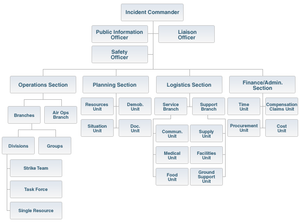Mass casualty incident
Background
- Mass Casualty Incident (MCI) defined as an incident where the number of patients (or the rate of their arrival to a medical facility) overwhelms local resources (and the ability to immediately supplement them).[1][2]
Potential Causes of MCI
Mass casualty incident
- Radiation exposure (disaster)
- Dirty bomb
- Bioterrorism
- Chemical weapons
- Mass shooting
- Natural Disaster (e.g. Hurricane, Earthquake, Tornado, Tsunami, etc)
- Unintentional large-scale incident (e.g. building collapse, train derailment, etc)
- Major pandemic
- Explosions
Management
Initial Triage
- In an MCI, triage differs slightly from normal Emergency Department triage.
- Based not only on severity of injury/illness, but also on prognosis/survivability in the setting of limited resources[3]
- START triage is the most common triage system utilized in the United States.
- Triage should be ongoing process, with patient statuses (and triage designations) updated as they change.
Incident Command System (ICS)
- Ensure the scene is safe
- Establish Incident Commander (IC)
- Request additional appropriate resources
- Additional ALS/BLS
- Fire resources (HAZMAT, heavy rescue, ect.)
- Medevac
- Establish landing zone
- Establish staging areas for resources
- No more than 8 people per supervisor
- 3-5 preferred
References
- ↑ Briggs SM. Disaster management teams. Curr Opin Crit Care. 2005 Dec;11(6):585-9.
- ↑ Lee JS, Franc JM. Impact of a Two-step Emergency Department Triage Model with START, then CTAS, on Patient Flow During a Simulated Mass-casualty Incident. Prehosp Disaster Med. 2015 Jun 24:1-7.
- ↑ Pesik N, Keim ME, Iserson KV. Terrorism and the ethics of emergency medical care. Ann Emerg Med. 2001 Jun;37(6):642-6.
- ↑ Cross KP, Petry MJ, Cicero MX. A better START for low-acuity victims: data-driven refinement of mass casualty triage. Prehosp Emerg Care. 2015 Apr-Jun;19(2):272-8. doi: 10.3109/10903127.2014.942481.
- ↑ Kahn CA, Schultz CH, Miller KT, Anderson CL. Does START triage work? An outcomes assessment after a disaster. Ann Emerg Med. 2009 Sep;54(3):424-30, 430.e1. doi: 10.1016/j.annemergmed.2008.12.035.



